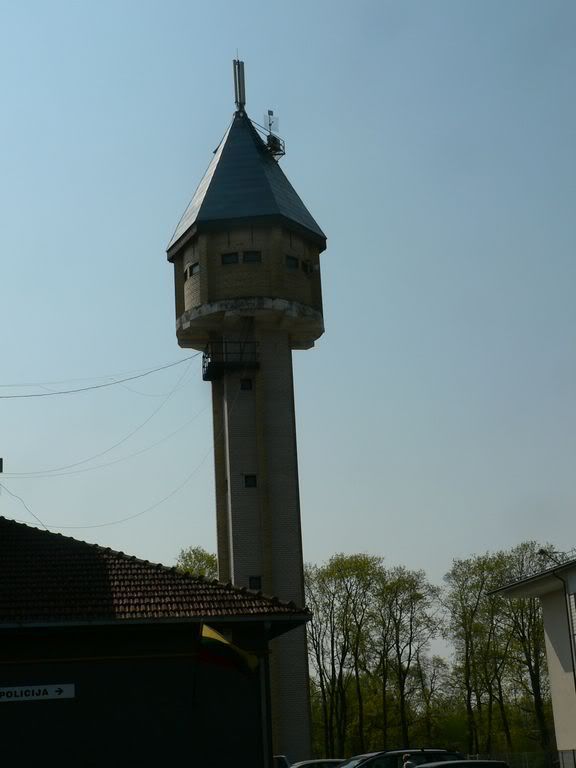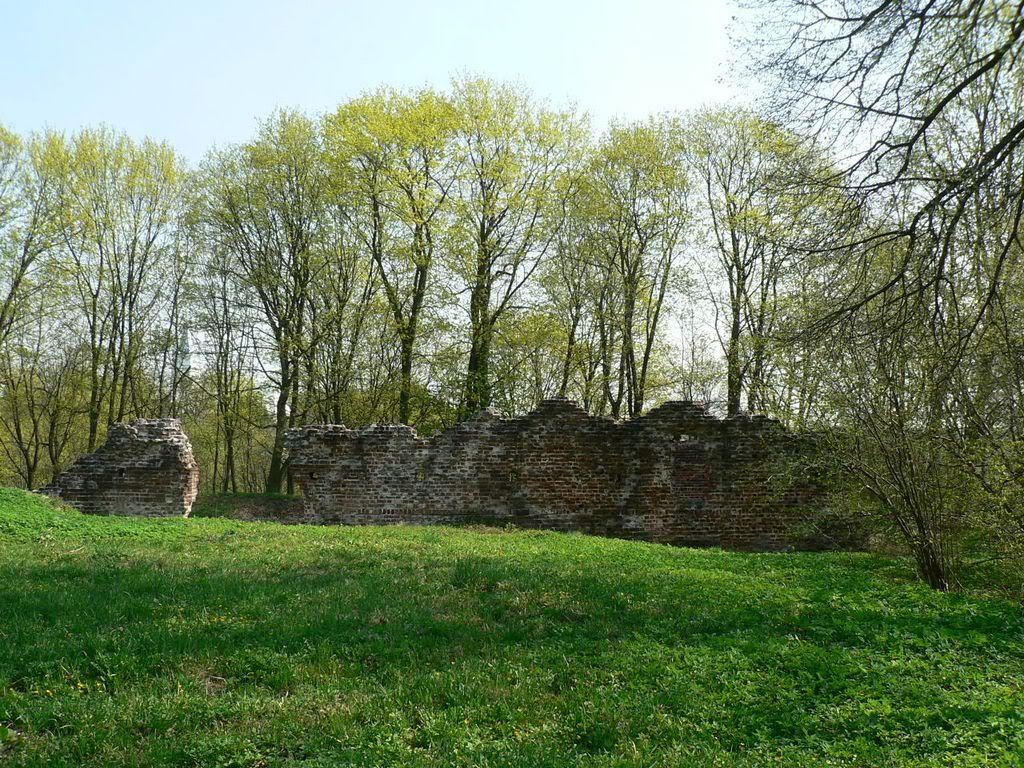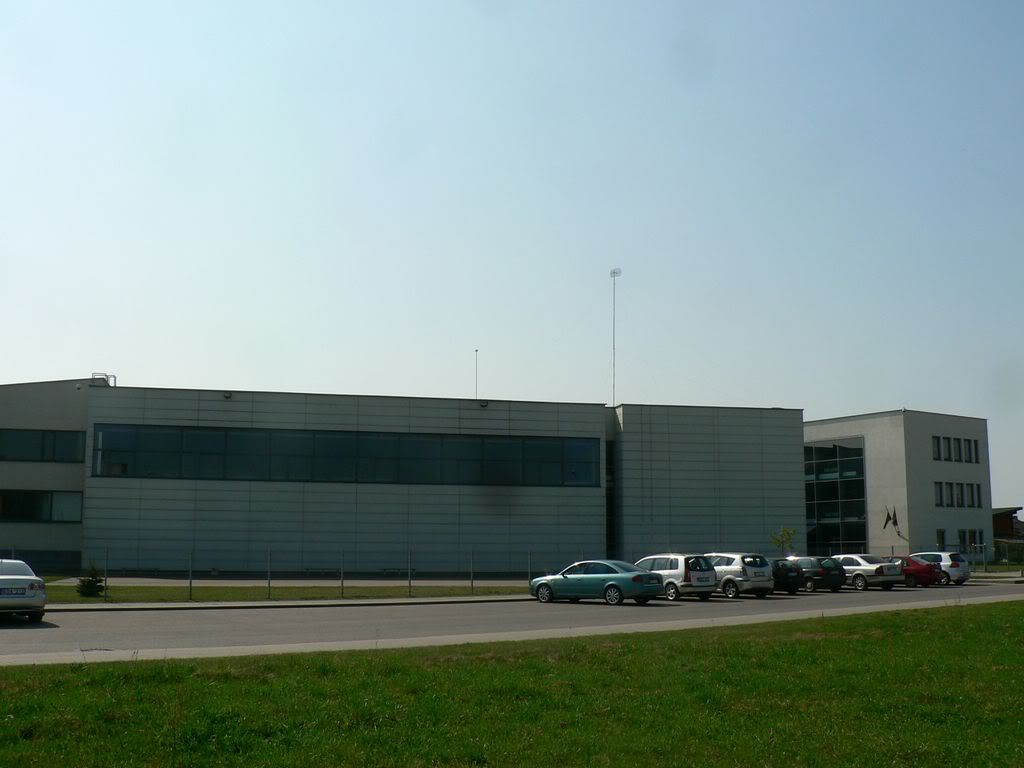Lapės - village with many attributes of a town
About 20 km to the north-east from Kaunas you can find village called Lapės (foxes in English). This village would be otherwise very typical village for this country but lapės has many attributes that could be related with town - the ruins of castle, the former TV station (in the early 1990s in Lapės was the headquarters and the central studios of the first commercial national TV company in Lithuania), etc. Near Lapės is the central dump of Kaunas region -also local big-name :)
So let's visit this not completely typical village .

One of the first buildings that you see on arrival to Lapės is the administration of village. This is former administration of Lapės kolhoz and the local culture house. Built probably in the middle of 1980's. Early in the 1990s it was bought by then successful businessman who established the first private commercial nation-wide TV company "Litpoliinter TV". So here was both the headquarters and studios of then probably the most popular TV station in the country and whole country could see the most influential people in the country talking and debating from the studios in the village :) In 1994 the company went on bankruptcy but soon the TV began to translate under the new name LNK TV. Still LNK TV is one of the most popular TV channels in Lithuania. Many programs were filmed and translated from Lapės till 1999 or even 2000 but then company moved it's bases to Vilnius. And the era of Lapės as one of the Lithuanian radio and TV centers ended. But anyway future historians will write about Lapės as the pioneering place of Lithuanian professional show industry. When TV left the village house is used as the local administration, police , etc.:

The tower near the administration:

Now I will go to the left from administration. In the prewar period in Lapės had it's residence A. Merkys - long time Kaunas burgomeister and the last prime-minister of Lithuania (he even performed the duties of President for a one day - from the middle of 15 June 1940 till the middle of June 16, 1940). In the 1990 bust to commemorate him was built:

And going even further we could find one of the oldest ruins in the country - former Lapės castle. This castle is probably least known from the former castles in Kaunas area. The castle has been ruined down by the Muscovy troops in the 1654-1655 and then wasn't rebuilt. So these ruins are almost the same as they were in the middle of XVIIth century:


Returning back to the center and going to the right from the administration building we can find Lapės school building. Built in 2002-2003 it is a rare examEle of entirely new school in Lithuania. School was built for the village since the central dump of Kaunas area is located about 5 km further from the village.
Entrance:

.
Few looks to the school:


even special traffic-light near the school :)))))))))))) It's really funny taking into account the traffic in the village.

The houses of local elite :))

few houses from the "mature socialism" period in the center:

Idiotically reconstructed shop also in the center:

The importance of the village is emphasized by the buses serving very important "Kaunas - Lapės" line. Ikarus E95 in Lapės :)))

But in principle Lapės is very typical village ...


Now we will go to the other side of village. Again reconstructed former shop of Lietkoopsajunga :

Behind it recently restored independence monument from 1928 (destroyed in 1950) - the creation of local folk-artists from that period:


Near the monument is the local cemetery with local church:

The church in Lapės is very interesting that it was built in 1614-1620 and is completely unchanged from that time:

Backview - the same as in the XVIIth century:

Spring view:)

In Lapės cemetery you can observe interesting phenomena - many Polish names. Lapės was the place were so called "Lapės-Vandžiogala- Kėdainiai" triangle started. This triangle was heavily Polonized part of Lithuania which even pre-WWII Lithuanian authorities were unable to break down. Of course here never real Poles lived nor the area saw massive migration of Poles - simply local Lithuanian peasants under the pressure of local szlachta and cler became to feel themselves as Poles. And even today you can find here some people proudly saying "Jestem Polakem" but their family names shows their clearly Lithuanian roots :) Some tombs from the cemetery - Nomeika became Nomeiko and Rimdeika became Rymdejko:



So let's visit this not completely typical village .

One of the first buildings that you see on arrival to Lapės is the administration of village. This is former administration of Lapės kolhoz and the local culture house. Built probably in the middle of 1980's. Early in the 1990s it was bought by then successful businessman who established the first private commercial nation-wide TV company "Litpoliinter TV". So here was both the headquarters and studios of then probably the most popular TV station in the country and whole country could see the most influential people in the country talking and debating from the studios in the village :) In 1994 the company went on bankruptcy but soon the TV began to translate under the new name LNK TV. Still LNK TV is one of the most popular TV channels in Lithuania. Many programs were filmed and translated from Lapės till 1999 or even 2000 but then company moved it's bases to Vilnius. And the era of Lapės as one of the Lithuanian radio and TV centers ended. But anyway future historians will write about Lapės as the pioneering place of Lithuanian professional show industry. When TV left the village house is used as the local administration, police , etc.:

The tower near the administration:

Now I will go to the left from administration. In the prewar period in Lapės had it's residence A. Merkys - long time Kaunas burgomeister and the last prime-minister of Lithuania (he even performed the duties of President for a one day - from the middle of 15 June 1940 till the middle of June 16, 1940). In the 1990 bust to commemorate him was built:

And going even further we could find one of the oldest ruins in the country - former Lapės castle. This castle is probably least known from the former castles in Kaunas area. The castle has been ruined down by the Muscovy troops in the 1654-1655 and then wasn't rebuilt. So these ruins are almost the same as they were in the middle of XVIIth century:


Returning back to the center and going to the right from the administration building we can find Lapės school building. Built in 2002-2003 it is a rare examEle of entirely new school in Lithuania. School was built for the village since the central dump of Kaunas area is located about 5 km further from the village.
Entrance:

.
Few looks to the school:


even special traffic-light near the school :)))))))))))) It's really funny taking into account the traffic in the village.

The houses of local elite :))

few houses from the "mature socialism" period in the center:

Idiotically reconstructed shop also in the center:

The importance of the village is emphasized by the buses serving very important "Kaunas - Lapės" line. Ikarus E95 in Lapės :)))

But in principle Lapės is very typical village ...


Now we will go to the other side of village. Again reconstructed former shop of Lietkoopsajunga :

Behind it recently restored independence monument from 1928 (destroyed in 1950) - the creation of local folk-artists from that period:


Near the monument is the local cemetery with local church:

The church in Lapės is very interesting that it was built in 1614-1620 and is completely unchanged from that time:

Backview - the same as in the XVIIth century:

Spring view:)

In Lapės cemetery you can observe interesting phenomena - many Polish names. Lapės was the place were so called "Lapės-Vandžiogala- Kėdainiai" triangle started. This triangle was heavily Polonized part of Lithuania which even pre-WWII Lithuanian authorities were unable to break down. Of course here never real Poles lived nor the area saw massive migration of Poles - simply local Lithuanian peasants under the pressure of local szlachta and cler became to feel themselves as Poles. And even today you can find here some people proudly saying "Jestem Polakem" but their family names shows their clearly Lithuanian roots :) Some tombs from the cemetery - Nomeika became Nomeiko and Rimdeika became Rymdejko:

